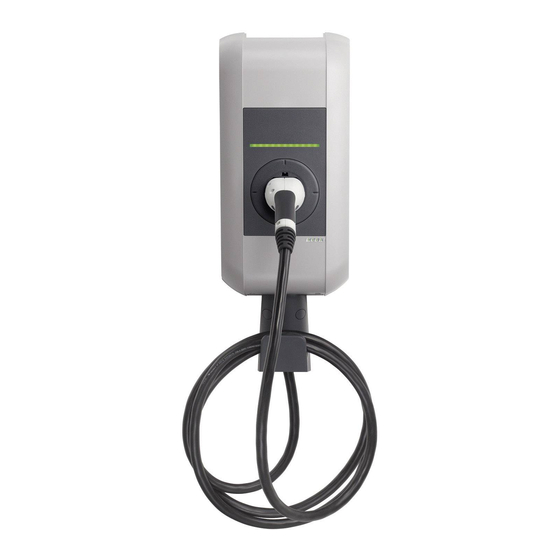
Keba KeContact P20 Udp Programmers Manual
Hide thumbs
Also See for KeContact P20:
- User manual (200 pages) ,
- Manual (128 pages) ,
- Installation manual (60 pages)
Table of Contents
Advertisement
Quick Links
Advertisement
Table of Contents

Summary of Contents for Keba KeContact P20
- Page 1 KeContact P20 Charging station UDP Programmers Guide V 3.00 Original manual...
- Page 2 Specifications are subject to change due to further technical developments. Details presented may be subject to correction. All rights reserved. Document: Revision 3.00 / Article no.: 92651 KEBA Energy Automation GmbH: Reindlstraße 51, 4040 Linz, Austria +43 732 7090-0, +43 732 7309-10, kecontact@keba.com For information about KEBA and our subsidiaries please look at www.keba.com.
-
Page 3: Table Of Contents
Contents Contents Introduction ............................ 4 Requirements ........................4 UDP commands..........................5 General information ....................... 5 Supported UDP commands ....................5 UDP Broadcast Messages ....................6 UDP command “i” ........................7 UDP command “failsafe” ....................... 7 UDP command „report“ ......................8 UDP command “ena”... -
Page 4: Introduction
Schematic overview (example) 1.1 Requirements The following requirements have to be met to use the UDP functionality: • KeContact P20 Charging station with network connection (LSA+ socket) - Product code: KC-P20-xxxxxx2x-xxx or KC-P20-xxxxxx3x-xxx - Firmware version: 2.5 or higher. •... -
Page 5: Udp Commands
UDP commands 2 UDP commands 2.1 General information When using UDP commands it is strongly recommended to protect your Smart-Home-Network on port 7090 against unauthorized control or external attacks. The charging station reacts on broadcasts and directly addressed commands. In a group of several charging stations, direct addressing should be used because otherwise all charging stations would react. -
Page 6: Udp Broadcast Messages
UDP commands 2.3 UDP Broadcast Messages The broadcast messages are intended to avoid the permanent polling of the following described reports. If there is a change of the status, the authorization, the enable input X1, the maximum possible current pre- sets (temperature reduction), or an increase of the energy value a message is generated for the change. -
Page 7: Udp Command "I
UDP commands 2.4 UDP command “i” UDP command: "Firmware":"KEBA P20 v 2.5a3 (160613-061001):29309:143.0" Reply: Description: Returns the product family and the firmware version of the charging station. Serves to a possible inventory of the network by means of a broadcast command with a subsequent report for detailed queries. -
Page 8: Udp Command: Report
UDP commands 2.6 UDP command „report“ report 1 UDP command: Reply: "ID": "1", "Product": "KC-P20-ES240010-000 ", "Serial": "15017355", "Firmware":"KEBA P20 v 2.01m11 (140610-073512)" Description: "ID" = ID of the retrieved report. "Product-ID" = Model name (variant) "Serial” = Serial number "Firmware"... - Page 9 UDP commands "Enable user" = Enable condition via UDP. "Max curr" = Current preset value via Control pilot in milliampere. "Max curr %" = Current preset value via Control pilot in 0,1% of the PWM value "Curr HW" = Highest possible charging current of the charging connection. Contains device maximum, DIP-switch setting, cable coding and temperature reduction.
-
Page 10: Udp Command "Ena
UDP commands 2.7 UDP command “ena” ena [n] UDP command: "TCH-OK :done" Reply: Description: = Is the enable state (binary). 0 = Disabled; is indicated with a blue flashing LED. The same as used with the external enable input. 1 = Enabled The answer TCH-OK confirms only the receiving of the command and not the cor- rectness of the value. -
Page 11: Udp Command "Output
UDP commands 2.9 UDP command “output” output [n] UDP command: "TCH-OK :done" Reply: Description: = Is the output state of the relay terminal X2 under the connector panel cover of the charging station (binary value). 0 = open 1 = closed >=10 = Pulse output with the specified number of pulses (pulses / kWh) and is stored in the EEPROM;...















Need help?
Do you have a question about the KeContact P20 and is the answer not in the manual?
Questions and answers